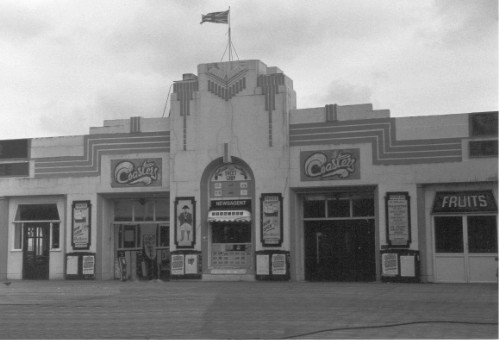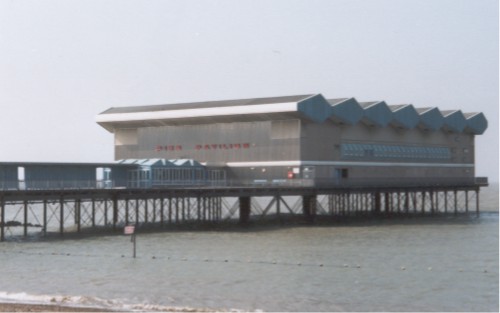Modern piers
There have been very few piers built since the First World War. However, due the precarious nature of piers - they are often prey to fires, collisions, and storm damage, several piers have been completely changed in the period from the thirties to the present day. This is a selection...
1930s

Hastings Pier. The shoreward end was given an Art Deco facade around 1930. There is more than a hint of the ancient Egyptian in this design.

The Grand Pier, Weston-super-Mare. The seaward pavilion (shown) was rebuilt in this style in 1933 after a fire. The angular lines of the 1930s design contrasts sharply with the more organic form of the wrought ironwork of an earlier era.
Sadly this pier was destroyed by fire on 28 July 2008.

The seaward pavilion at Worthing was rebuilt in 1936 as part of a scheme to redevelop most of the pier. This building is in a nautical style. It was used in the filming of the television film "Gor Blimey!" about the off-screen relationship between stars Sid James and Barbara Windsor. It stood in for the West Pier at Brighton which was used in the filming of "Carry on Girls" in 1973.
The 1950s & 1960s
In many respects, the 'fifties, 'sixties and early 'seventies were the golden age of the British seaside holiday. Visitor numbers were at their highest. Widespread car ownership made a trip to the seaside well within reach for most people. Seaside towns redeveloped facilities damaged in the War and gave the seaside a new, modern look.
During the Second World War, many piers on the South Coast were breached to stop a potential invasion threat. After the War many needed extensive repair work. Two of the best examples of the new modern look for piers are to be found at neighbouring Bournemouth and Boscombe.
Bournemouth Pier

The Pier Theatre, Bournemouth was opened on 3rd June 1960 with the show "Carry on Laughing" starring Ted Rogers. There was a new show at the Pier Theatre each year. In 1964, Thora Hird starred in "The Best Laid Plans". In 1966, Sid James was in "George & Alfred Black present 'Spring Wedding'". He was followed by Dick Emery in 1967 ("Oh! You are Awful"). The popular comedy "The Mating Game" was performed in 1969 and 1971. "No Sex Please We're British" was first performed at the Pier Theatre in 1973 and again in 2000 (left). For the children there was "Sooty" with Harry Corbett (1968) and "Rupert Bear" (1975).
Boscombe Pier

The original Boscombe Pier was built in 1888 by a private company, but was sold to the Bournemouth Corporation in 1903. The pier head was added in 1926. Like many piers on the South Coast, Boscombe Pier did not have a happy time during the War. It was requisitioned in 1940 and as a precaution against use by invading forces, a section was demolished. By the mid 'fifties, it was little more than a rusting skeleton.
In 1955, the Council was notified by the Ministry of Housing and Local Government that an application to reconstruct the Pier would be considered. Drawing and design work was carried out by the Borough Engineer's Department and work began in 1958. The pier head, which was built in 1926, was of reinforced concrete construction and was repairable. The neck, a much older structure in traditional cast iron, was beyond repair and was replaced by a new structure in reinforced and pre-stressed concrete. The most exciting feature of the new development was the pier entrance, which was built in a modern style, with a reinforced concrete platform and a cantilevered roof. This building particularly captured the style of the era. The thin curved roof echoed the delta wings of a jet aircraft. The exterior was finished in cream, yellow and pale blue tiles. These colours were particularly popular in the early 'sixties.
 What
to do with the pier head was quite an issue in the late 'fifties. At a
late stage in the construction, it was decided to build a concert hall
on the pier head. This meant more piles had to be driven into the sea
bed to support it. The concert hall - known as "The Mermaid" was built
with a steel frame, but was covered with wooden weather boarding. The
original colour scheme was white framework with blue and gold panels.
There was considerable debate about what to use the "Mermaid" for. It
was finally decided that it should be used for roller skating. In spite
of this, there was still a stage and facilities for a concert hall in
the same building.
What
to do with the pier head was quite an issue in the late 'fifties. At a
late stage in the construction, it was decided to build a concert hall
on the pier head. This meant more piles had to be driven into the sea
bed to support it. The concert hall - known as "The Mermaid" was built
with a steel frame, but was covered with wooden weather boarding. The
original colour scheme was white framework with blue and gold panels.
There was considerable debate about what to use the "Mermaid" for. It
was finally decided that it should be used for roller skating. In spite
of this, there was still a stage and facilities for a concert hall in
the same building.
The new pier was opened on 6 June 1962 by the Mayor, Councillor Adams. The "Mermaid" was opened for roller skating at the same time. There were three sessions each day. The "Mermaid" also offered "modern twist dancing" to the Sands Combo for six shillings at different times of the day. The skating sessions were accompanied by "Top Twenty" hits broadcast through the new hi-fi system.
The roller skating did not prove a great hit. In 1965, Bournemouth Corporation finally bowed to the inevitable and allowed amusements on the Pier. This move was opposed by some Council members who thought it would change Bournemouth's traditional seaside character, but on 4 June 1965 over one hundred years of banning amusements came to an end and the 50,000 centre was opened. Amongst the delights on offer were bingo, a rifle range, miniature ten pin bowling, electronic gambling machines that staged a miniature Grand National and of course, the one-arm bandit type slot machines. There were also a couple of machines of an older vintage presenting scenes such as "The Haunted House" - but "What the butler saw" was still considered too racy!
 The entrance to Boscombe Pier is now to be saved. English Heritage
have granted it listed status. It will now form part of
Bournemouth Council's plans to redevelop the area.
The entrance to Boscombe Pier is now to be saved. English Heritage
have granted it listed status. It will now form part of
Bournemouth Council's plans to redevelop the area.
The 1970s

Herne Bay Pier. This is what remains of a much longer pier. This section was built in 1976 as a sports and leisure centre to a design by John Clague.
More on piers:
The National Piers Society
This site is a source of news and other information about piers. It contains photographs of the 55 remaining piers and links to other pier-related web sites.